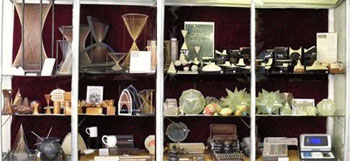- About MAA
- Membership
- MAA Publications
- Periodicals
- Blogs
- MAA Book Series
- MAA Press (an imprint of the AMS)
- MAA Notes
- MAA Reviews
- Mathematical Communication
- Information for Libraries
- Author Resources
- Advertise with MAA
- Meetings
- Competitions
- Programs
- Communities
- MAA Sections
- SIGMAA
- MAA Connect
- Students
- MAA Awards
- Awards Booklets
- Writing Awards
- Teaching Awards
- Service Awards
- Research Awards
- Lecture Awards
- Putnam Competition Individual and Team Winners
- D. E. Shaw Group AMC 8 Awards & Certificates
- Maryam Mirzakhani AMC 10 A Awards & Certificates
- Two Sigma AMC 10 B Awards & Certificates
- Jane Street AMC 12 A Awards & Certificates
- Akamai AMC 12 B Awards & Certificates
- High School Teachers
- News
You are here
Keys to Mathematical Treasure Chests: 19th-century String Models
Roughly forty years ago, a young mathematician teaching about three-dimensional surfaces in a course at Amherst College in Massachusetts laboriously drew an image on the blackboard. A student inquired if the figure represented the same surface as a plaster model sitting in a case at the back of the classroom—part of a group of models the instructor had never carefully examined. It did.

Figure 1. Display case of mathematical objects such as the Amherst student might have noticed.
Assembled at the University of Arizona, ca 1998.
This revelation did not inspire either the student or the mathematician to study the models carefully. However, this anecdote reminds us that Amherst is not the only institution to have invested in models and other teaching apparatus in earlier days. Whether such objects would still assist in teaching specific mathematical topics, I cannot say. They do offer a way to better understand mathematical pedagogy, communities within mathematics, and connections between mathematics and such other disciplines as engineering and the visual arts.
Collections of mathematical instruments in museums, universities, and schools can include general teaching devices from the slate and blackboard to graph paper to the white board. They may comprise digital tools for carrying out arithmetic operations, such as the abacus, adding and calculating machines, and cash registers. Analog computing devices ranging from astrolabes to drawing instruments of various sorts to slide rules may also be found in collections. However, mathematicians intrigued by objects probably puzzle most often over various sorts of mathematical models. As stated above, these objects—made from plaster, wood, metal, string, or plastic—adorn the halls of some mathematics buildings and, sometimes, classrooms. Some of these were purchased from afar, some were constructed locally. Most have been produced by human handiwork, but three-dimensional printing now plays a role. In what follows, I shall describe chronologically one tradition in making models of surfaces that emerged in 19th-century French engineering, was continued by mathematical model makers in Germany and elsewhere, and even influenced the development of string sculpture by Henry Moore and others. There already are fine historical accounts of much of this work—as is the raison d’etre of this series, my emphasis will be on a few databases that allow one to see the stuff . . . or at least images of it!
Peggy Aldrich Kidwell (National Museum of American History, Smithsonian Institution), "Keys to Mathematical Treasure Chests: 19th-century String Models," Convergence (July 2021)




